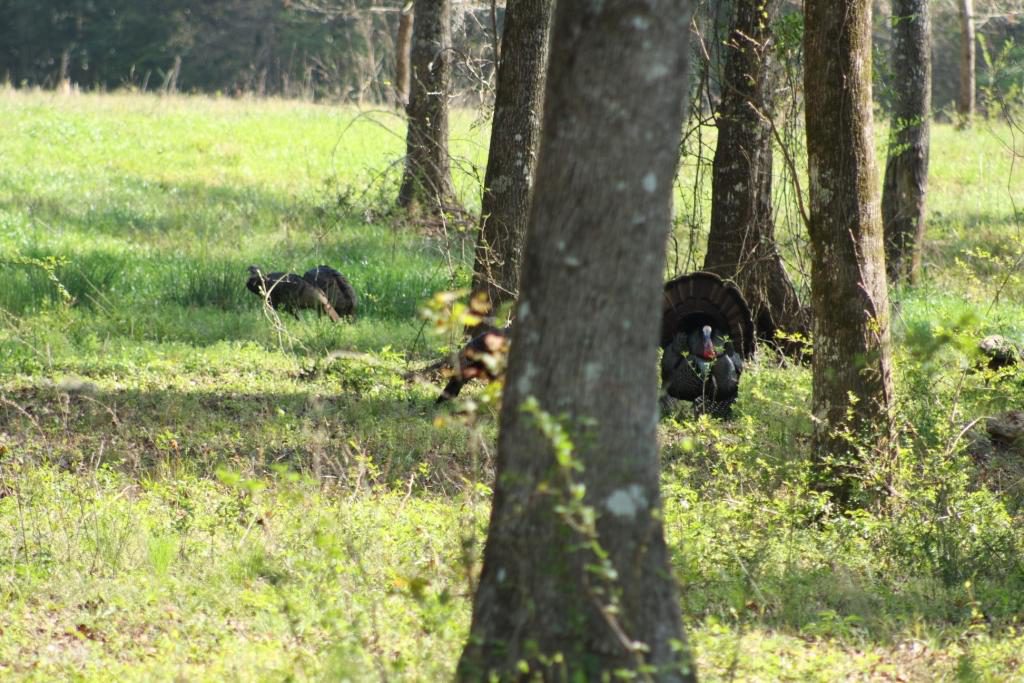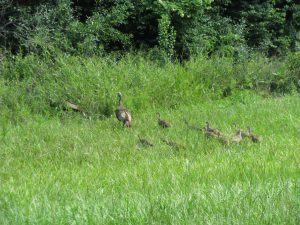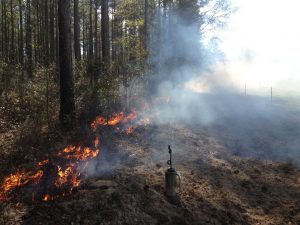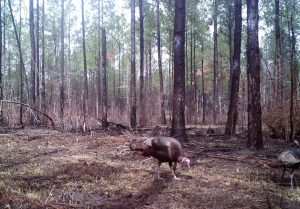The above picture of a strutting Eastern Wild Turkey is a sight that many hunters look forward to seeing every spring here in the panhandle of Florida. In order to manage wild turkeys and their habitat it is good to understand some basic facts about their biology.
Wild turkeys are considered a generalist species, meaning that they can eat a wide variety of foods, primarily seeds, insects, and vegetation. They prefer relatively open ground cover so that they can see well and easily move through their surroundings, but they aren’t picky about where they live as long as it provides them year-round groceries and safety. They are also a very adaptable species. Turkeys prefer low, moderately open herbaceous vegetation (less than three feet in height) that they can see through, or see over, and through which they can easily move in relatively close proximity to forested cover. Such open habitat conditions help them see and avoid predators and these areas will typically provide sufficient food in terms of edible plants, fruit, seeds, and insects.
Wild turkeys are considered, ecologically, to be a “prey species” and have evolved as a common food source for numerous animals—seems everything is trying to eat them. Turkey eggs, young (i.e.,poults), and adults are preyed on by such animals as bobcats, raccoons, skunks, opossum, fox , coyotes, armadillos, crows, owls, hawks, bald eagles, and a variety of snakes. Being prey to so many different animals has shaped the turkey’s biology and behavior. Turkeys experience high mortality rates and don’t live very long, on average, <2 years. They are particularly vulnerable during nesting and immediately after hatching. Because of this high mortality, reproduction is really important for turkey populations to replace the individuals that don’t survive from year to year. Wild turkeys have adapted to being a prey species in part, though, by having a high reproductive potential. Hens have the capacity to lay large clutches of eggs. If a nest is destroyed or disturbed, especially during the egg laying or early incubation period, the hen will often re-nest. Turkeys are also polygamous, with males capable of breeding multiple females, which further boosts their reproductive potential.
Newly hatched turkeys, referred to as poults, need grassy, open areas so they can find an abundance of insects. Such areas are usually the most critical, and often the most lacking habitat in Florida. Under ideal conditions for turkeys, grassy openings would occupy approximately 25 percent of a turkey’s home range. Additionally, it is of equal importance to have such openings scattered throughout an area, varying in size from 1 to 20 acres such that they are small, or irregular in shape, to maximize the amount of adjacent escape cover (moderately dense vegetation or forested areas that can provide concealment from predators or other disturbances). Large, expansive openings (e.g., large pastures) without any escape cover are not as useful for turkeys since they generally will not venture more than 100 yards away from suitable cover.
Good habitat allows turkeys to SEE approaching danger and to MOVE unimpeded (either to move away from danger or simply to move freely while foraging without risk of ambush). In other words, good habitat provides the right vegetative structure. When thinking about habitat for turkeys, it’s good to always think from a turkey’s point of view….about 3 feet off the ground! Turkeys like open areas where they can see well and easily move.
One of the best management techniques to manage vegetation structure and composition is prescribed fire. Fire can be very destructive, but if properly applied, fire can be quite beneficial to wildlife and is one of the best things you can do for wild turkeys. When applied correctly, fire has many benefits. Some of the benefits of fire to turkeys and other wildlife include: control of hardwood by setting back woody shrubs and trees in the under story; improving vegetation height and structure; stimulating new herbaceous growth at ground level; stimulating flowering and increased fruit production in some plants; it improves nutritional value and increases palatability of vegetation. All of this leads to increased insect abundance and fewer parasites in the environment. Prescribed fire also has benefits for the landowner. Applied properly and regularly, prescribed fire will reduce risk of catastrophic wildfire which can destroy a timber stand. It reduces hardwood competition so favored pines grow faster and healthier; and reduces the risk of disease, particularly after a thinning or timber cut, by removing logging debris that would otherwise attract insects and disease-causing agents. It can also help control invasive species, and best of all it’s the least expensive option on a cost per acre basis.
Another good practice is simply mowing or bush-hogging. Even in areas that aren’t super thick (such as around forest and field edges, or seasonal wetlands), mowing and bush-hogging alone, even without fire, are beneficial as they have much the same effect on the habitat as fire. Basically, you’re removing grown up vegetation and allowing light to reach the ground again. Within pine plantations, roads often provide some of the best, or only, turkey habitat simply because the surrounding vegetation becomes too dense so roads are used for feeding and moving throughout the area. In this regard, wide roads increase the amount of open habitat which provides lots of insects, seeds, and edible vegetation. They also reduce the opportunity for predators to ambush turkeys which can readily occur on narrow roads. Having wide roads is a good land management practice that lets roads dry-out quicker so that they can hold up to traffic better.
If you have pine dominated timber stands on your property, proper thinning is not only good for turkeys, but it’s good for your stand. Young pine stands, particularly those in sapling or early pole stages, are often too thick for wild turkeys, except as escape cover. They get so dense that they shade out everything underneath. They may produce some pine seeds when they get older, but for most of the year, there’s nothing to eat and nothing to attract turkeys to the area. For turkeys, thinning opens up the canopy and allows sunlight to reach the forest floor, which in turn stimulates plant growth of grasses, forbs and soft-mast producing shrubs.
If you have an interest in turkeys, do most management activities outside of the nesting season, which generally runs from the middle of March through June. From a practical standpoint that is not always possible, so on the positive side, if a nest is destroyed (whether by predators or management efforts), a hen will quite often re-nest. Also, the overall importance of management will often outweigh the loss of 1 or 2 nests. The time that turkey nests are at a premium is when a turkey population is low or just trying to get established into an area. In such cases every nest is valuable.
For more information consult with your local Extension Agent .
- Wildlife Food Plots: Chufa for Wild Turkeys - March 27, 2020
- Wild Turkey Biology and Habitat Management - November 14, 2019
- Aquatic Weed Control – Common Salvinia - September 13, 2019




